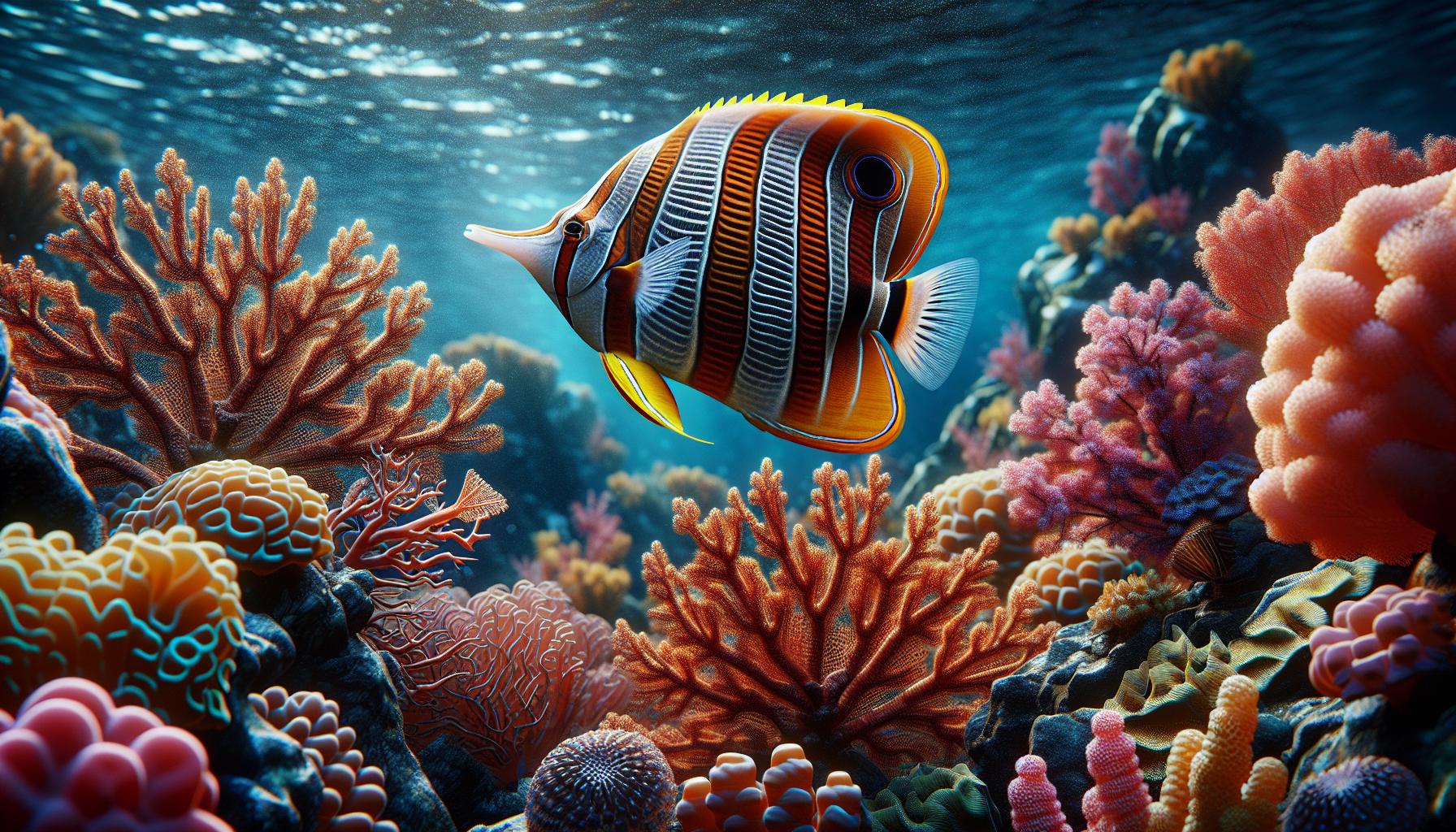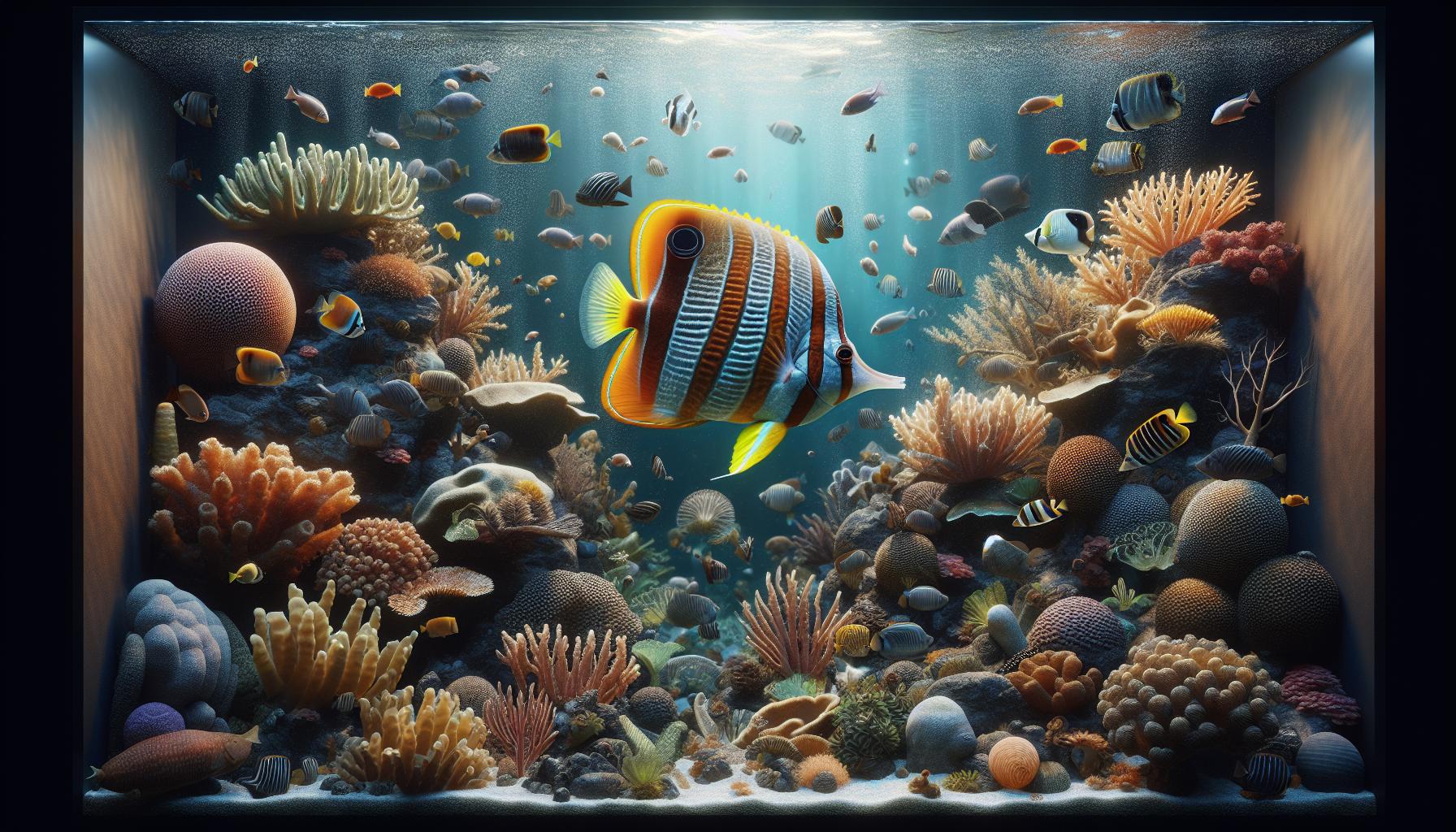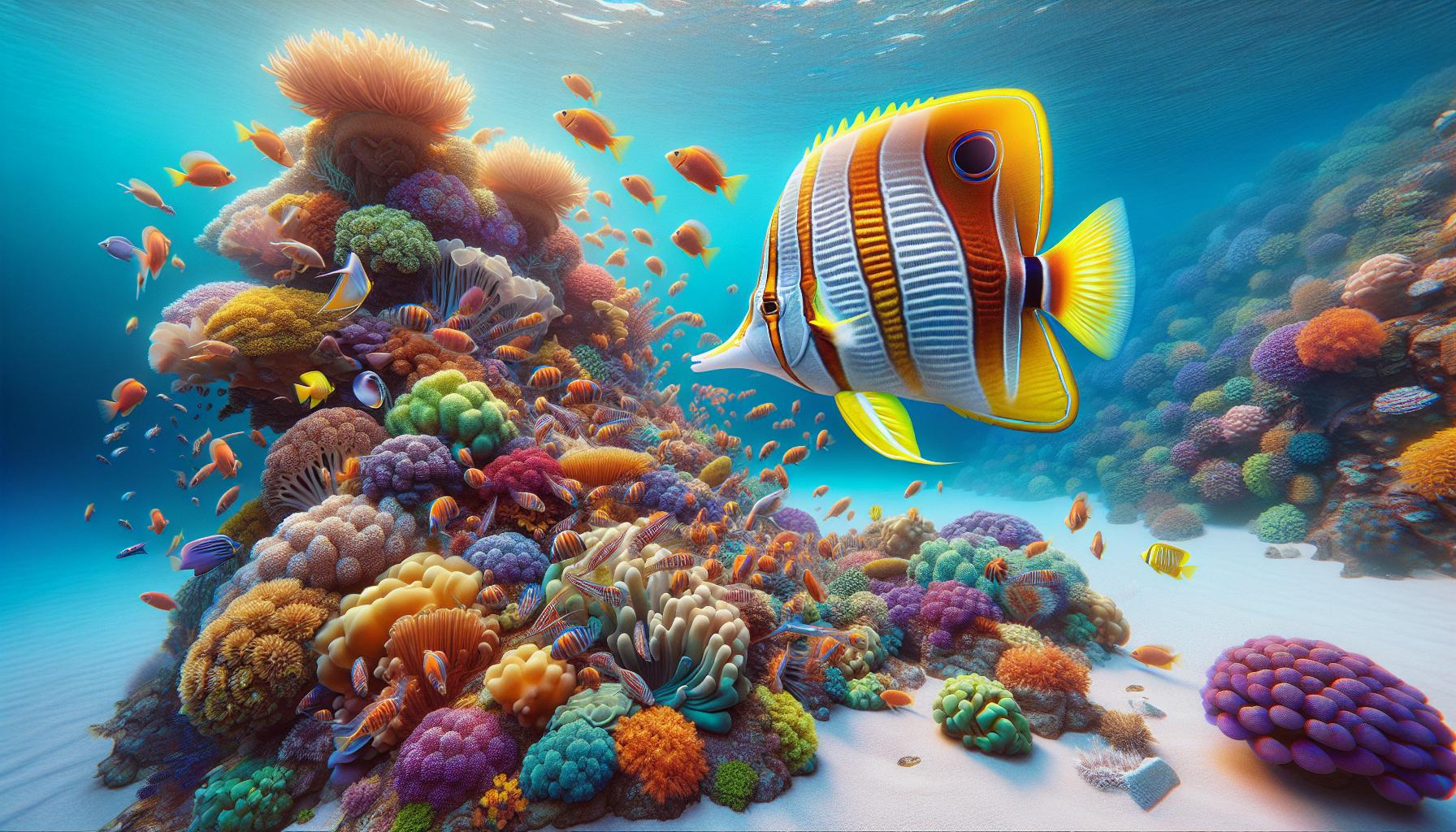Copperband Butterflyfish, with their striking bands and elegant demeanor, have always fascinated me. These marine beauties aren’t just a sight to behold in the vast oceans but also a popular choice for home aquariums. Their unique appearance and behavior make them a topic of interest among enthusiasts and beginners alike.
Delving into the world of Copperband Butterflyfish, I’ve learned that they’re more than just pretty faces. Their care, feeding habits, and role in the ecosystem highlight their importance in marine life. Join me as we explore the captivating world of these magnificent fish, understanding what makes them a jewel of the ocean.
Key Takeaways
- Copperband Butterflyfish are notable for their distinct vertical bands, slender bodies, and a long snout, making them a visually captivating species both in the wild and in home aquariums.
- Their unique feeding behavior on small invertebrates, such as tube worms and small crustaceans, positions them as important pest controllers in both natural reef ecosystems and aquarium settings, emphasizing their utility beyond aesthetic appeal.
- Proper care for Copperband Butterflyfish in aquariums requires a well-established environment that mimics their natural habitat, with special attention to water quality, ample space (preferably over 75 gallons for sufficient territory), and a diet that caters to their natural feeding habits.
- These fish play a critical role in the health of coral reef ecosystems by consuming pests and invertebrates that can harm reef structures, highlighting their ecological importance alongside their ornamental value.
- Socially, Copperband Butterflyfish tend to display peaceful behavior but can become territorial towards their own kind, underscoring the need for careful planning and management in aquariums where multiple individuals are present.
- Understanding and replicating the natural conditions and behaviors of Copperband Butterflyfish in home aquariums can lead to healthier, more vibrant fish, offering aquarists a rewarding experience while contributing to the preservation of a fascinating marine species.
Copperband Butterflyfish: A Fascinating Species

Diving deeper into the world of marine aquariums, I’ve always been captivated by the elegance of the Copperband Butterflyfish. Known scientifically as Chelmon rostratus, these fish are a testament to the beauty and complexity of marine life. With their slender bodies, distinct vertical bands, and a long snout, they’re not just a favorite among aquarists but also play a crucial role in their natural habitat.
What fascinates me the most is their unique feeding behavior. Copperband Butterflyfish have a penchant for small invertebrates and are particularly adept at controlling pests in aquariums, such as Aiptasia, a type of nuisance anemone. This makes them not just aesthetically pleasing but also incredibly useful. Their diet in the wild consists mainly of:
- Small crustaceans
- Worms
- Mollusk larvae
Caring for these delicate creatures in a home aquarium requires a well-established environment. They thrive in tanks that mimic their natural habitats with plenty of live rock and hiding spots. Water quality is paramount, as they are sensitive to changes in their environment, indicating the need for regular maintenance and monitoring.
Socially, Copperband Butterflyfish exhibit fascinating behavior. They’re generally peaceful but can show territorial aggression towards their kind. It’s best to house them singly unless the aquarium is large enough to support a pair comfortably, emphasizing the importance of understanding their needs for a harmonious tank.
While their beauty is undeniable, it’s their contribution to the balance of the reef ecosystem that underscores their value. They help in keeping coral reefs healthy by consuming coral predators, highlighting an intricate relationship between species.
In my journey of exploring marine life, the Copperband Butterflyfish stands out not just for their striking appearance but for the role they play in their underwater world. Their presence in home aquariums adds a layer of complexity and beauty, merging aesthetics with functionality in fascinating ways.
The Exquisite Appearance of Copperband Butterflyfish

When I first set my eyes on Copperband Butterflyfish, I couldn’t help but be mesmerized by their stunning appearance. This distinct feature doesn’t just attract novice aquarists like me; it captivates everyone. The combination of vibrant colors and striking patterns makes them a standout in any reef aquarium.
Their elongated bodies, which can reach up to 8 inches in length, are adorned with bold, vertical yellow and white bands that run the length of their bodies. This striking coloration isn’t just for show; it plays a crucial role in their survival, helping them blend into the coral reefs they inhabit and ward off predators.
One cannot overlook their unique, long snouts, which serve as an essential tool for their survival. This specialized adaptation allows them to reach into crevices in the coral reefs to feed on their prey, primarily consisting of tube worms, small crustaceans, and other coral-dwelling invertebrates. It’s a testament to the intricate balance of nature, where form meets function in the most beautiful ways.
Their dorsal and anal fins have a delicate, almost translucent quality, with a hint of orange that complements their striking body coloration. The fluid movement of these fins as they glide through the water is utterly captivating, showcasing the grace and agility of Copperband Butterflyfish.
The sight of Copperband Butterflyfish in a well-maintained aquarium is nothing short of enchanting. Their presence adds not only beauty but a remarkable display of the wonders of marine life. Each time I observe them, I’m reminded of the incredible diversity and complexity of ocean ecosystems, making me appreciate these exquisite creatures even more.
The Behavior of Copperband Butterflyfish
Observing Copperband Butterflyfish in their natural habitat or in a well-structured aquarium setting reveals fascinating aspects of their behavior. These exquisite fish are known for their peaceful demeanor but can exhibit territorial actions when it comes to their own kind. It’s a delicate balance, maintaining harmony in an aquarium with these captivating creatures.
One of the most notable behaviors of Copperband Butterflyfish is their method of feeding. With their slender, elongated snouts, they’re adept at sniping small prey hidden in the crevices of coral reefs. This not only showcases their unique feeding technique but also underlines their importance in maintaining the health and balance of reef ecosystems. They play a crucial role in controlling populations of pests, such as bristle worms and coral-eating flatworms, which can otherwise overrun coral communities.
Social interaction among Copperband Butterflyfish is another area of interest. They tend to be solitary or found in pairs, especially during breeding season. It’s during this time that their behavior can become slightly more aggressive as they defend their chosen territory. I’ve found that providing ample space and hiding spots can significantly reduce stress and aggression in these fish.
In the aquarium, their behavior often reflects the conditions of their environment. A well-maintained tank that closely mimics their natural habitat can lead to more vibrant and active Copperband Butterflyfish. It’s not uncommon to see them engaging in what appears to be playful behavior, darting through the water and exploring every nook of their surroundings. Providing a varied diet that replicates their natural food sources can also encourage natural feeding behavior, making for a more dynamic and fascinating display.
Ultimately, understanding and catering to the unique behaviors of Copperband Butterflyfish can make all the difference in maintaining their health and vibrancy in captivity. Whether it’s through careful selection of tank mates, providing a suitable environment, or offering the right diet, there’s much we can do to ensure these beautiful fish thrive.
Captivating Copperband Butterflyfish in Home Aquariums
Introducing the mesmerizing Copperband Butterflyfish to your home aquarium transforms it into a slice of the ocean’s canvas. Their ethereal beauty doesn’t just capture the eye; it enriches the aquatic environment with their dynamic presence and intriguing behaviors.
Creating a Suitable Habitat is paramount. These fish thrive in well-structured settings that mimic their natural coral reef homes. My own experience underscores the importance of including plenty of live rock and spaces for them to explore. They’re not just for show; these elements facilitate natural behaviors and contribute to the overall well-being of the Copperband Butterflyfish.
Feeding these magnificent creatures can be a bit tricky but gratifying. Their preference for live meals, like small worms and crustaceans, means setting up a feeding regime that’s both natural and sustainable. Diverse diet enhances their color and vitality, a fact that’s well-documented among enthusiasts and experts alike.
Ample space is another critical consideration. Given their territorial nature, Copperband Butterflyfish need room to roam and establish territories. Without sufficient space, stress and aggression can become issues, both of which are detrimental to their health. A larger tank, preferably over 75 gallons, is ideal for maintaining harmony and supporting their intricate social dynamics.
Lastly, water quality cannot be overstated. These fish are sensitive to changes in their environment, making stable water conditions a crucial aspect of their care. Regular water testing and maintenance are part of my weekly routine, ensuring a safe and healthy habitat for these captivating creatures.
Integrating Copperband Butterflyfish into a home aquarium is not just about showcasing their beauty. It’s about creating a thriving ecosystem where they can exhibit their natural behaviors. The rewards of observing these fish in a well-maintained environment are immense, offering a glimpse into the complexity and magnificence of marine life.
Caring for Copperband Butterflyfish: Feeding and Maintenance

When it comes to the well-being of Copperband Butterflyfish in captivity, understanding their dietary needs is paramount. I’ve learned through experience that these stunning creatures thrive on a varied diet. Their natural inclination is to pick at small invertebrates in coral reefs. In an aquarium setting, mimicking this diet promotes not only their health but also their natural foraging behavior. Foods like mysis shrimp, brine shrimp, and especially small pieces of clam or mussel can be particularly appealing to them. It’s also beneficial to introduce live foods into their diet, which can stimulate their natural hunting instincts and keep them engaged.
Feeding these fish can be challenging at first, especially if they are shy or slow to acclimate to their new environment. I’ve found success in feeding them small amounts multiple times a day. This not only ensures they’re getting enough food but also helps reduce competition and stress if there are other fish in the tank.
Beyond their diet, water quality cannot be overstated in its importance for Copperband Butterflyfish. They are sensitive to changes in their environment, which means regular water testing and maintenance are non-negotiables. The following table outlines the ideal water parameters for Copperband Butterflyfish:
| Parameter | Ideal Range |
|---|---|
| Temperature | 72-78°F (22-25.5°C) |
| pH | 8.1-8.4 |
| Salinity | 1.020-1.025 |
| Ammonia & Nitrite | 0 ppm |
| Nitrate | <20 ppm |
Sticking to these parameters and performing regular water changes will go a long way in keeping these fish healthy and vibrant.
Lastly, the aquarium setup itself plays a critical role in their well-being. A mixture of live rock and ample space for swimming can replicate their natural habitat and encourage exploration and exercise. I also ensure there are plenty of hiding spots available to help them feel secure and reduce stress.
The Role of Copperband Butterflyfish in the Ecosystem

In exploring the Copperband Butterflyfish’s niche, I’ve found their role in marine ecosystems to be both fascinating and beneficial. These fish are not just a pretty face in the aquarium; they serve a vital purpose in controlling pest populations, thereby maintaining the health and balance of coral reefs. Let’s dive deeper into this critical role.
Copperband Butterflyfish are known for their select diet, primarily consisting of benthic invertebrates, which include tube worms, small crustaceans, and coral polyps. This diet preference positions them as natural pest controllers. By feeding on pests that can harm coral reefs, such as the Aiptasia, a type of sea anemone considered invasive in many aquariums, these fish help to preserve the structural integrity and biodiversity of their habitat.
Here’s a table that outlines key dietary preferences of Copperband Butterflyfish and their impact on the ecosystem:
| Prey | Impact on Ecosystem |
|---|---|
| Tube Worms | Controls population, preventing overgrowth |
| Small Crustaceans | Keeps crustacean populations in check |
| Coral Polyps | Participates in the delicate balance of coral reef life |
| Aiptasia | Reduces numbers of invasive species harmful to reef health |
The presence of Copperband Butterflyfish on reefs aids in the biological control of species that, if left unchecked, could cause significant damage. Through their feeding habits, these fish promote a healthier reef by enabling more diverse and robust coral populations.
This symbiotic relationship between Copperband Butterflyfish and coral reefs highlights the interconnectedness of ocean species. By performing their role as pest regulators, they not only contribute to the vibrancy and diversity of their environments but also underline the importance of every species in maintaining ecological balance.
By understanding the essential function these beautiful fish play in their natural habitats, we can better appreciate their value and the need to protect them and their ecosystems. As we replicate their natural environment in our aquariums, we’re reminded of the delicate balance required to sustain healthy marine life and the critical roles different species play within it.
Conclusion: A Jewel of the Ocean – Copperband Butterflyfish
Copperband Butterflyfish truly embody the beauty and intricacy of marine life. Their vibrant colors and unique patterns not only captivate the eye but also serve a crucial role in the health of coral reefs. By controlling pest populations, these fish ensure the balance and diversity of their ecosystems. Their feeding habits, requiring a specific environment, remind us of the importance of replicating their natural habitat in aquariums. This not only supports their wellbeing but also allows us to witness their graceful movements and social behaviors up close. Whether observed in the wild or in the home aquarium, Copperband Butterflyfish are a testament to the wonders of the aquatic world. Their presence underscores the importance of conservation efforts and the need to protect our oceans’ biodiversity. Let’s cherish and protect these jewels of the ocean so future generations can also marvel at their beauty and benefit from their ecological contributions.
Frequently Asked Questions
What is unique about the feeding behavior of Copperband Butterflyfish?
Copperband Butterflyfish have a specialized diet, feeding on benthic invertebrates such as tube worms, small crustaceans, and coral polyps. Their long snouts allow them to reach into crevices in coral reefs to feed on prey, playing a crucial role in controlling pest populations in their ecosystem.
How do Copperband Butterflyfish help control pests in aquariums?
By consuming a diet consisting of tube worms, small crustaceans, coral polyps, and particularly invasive species like Aiptasia, Copperband Butterflyfish help maintain the health and balance of aquarium ecosystems. Their feeding behavior naturally controls populations of pests that could otherwise harm the aquatic environment.
What are the key aspects of creating a suitable environment for Copperband Butterflyfish in home aquariums?
A well-maintained aquarium that mimics the Copperband Butterflyfish’s natural habitat is essential. This includes providing ample space, hiding spots to reduce stress and aggression, and a varied diet to encourage natural feeding behavior. These elements are crucial for their health and well-being.
Can you describe the appearance of Copperband Butterflyfish?
Copperband Butterflyfish are known for their vibrant colors, striking patterns, and elongated bodies. They have unique long snouts, delicate and translucent dorsal and anal fins, and demonstrate graceful movements in water. Their exquisite appearance makes them an enchanting addition to well-maintained aquariums.
What is the social behavior of Copperband Butterflyfish?
Copperband Butterflyfish exhibit both solitary and paired behavior, especially during the breeding season. They are generally peaceful but can display territorial aggression. Providing ample space in the aquarium and hiding spots can mitigate stress and aggression, encouraging harmonious social interactions.
How do Copperband Butterflyfish contribute to the health and balance of reef ecosystems?
Copperband Butterflyfish play a vital role in maintaining the ecological balance of reef ecosystems by feeding on benthic invertebrates, including pests. This diet helps control populations of invasive species and other potential threats to the health of coral reefs, demonstrating the interconnectedness and importance of each species in ocean ecosystems.

